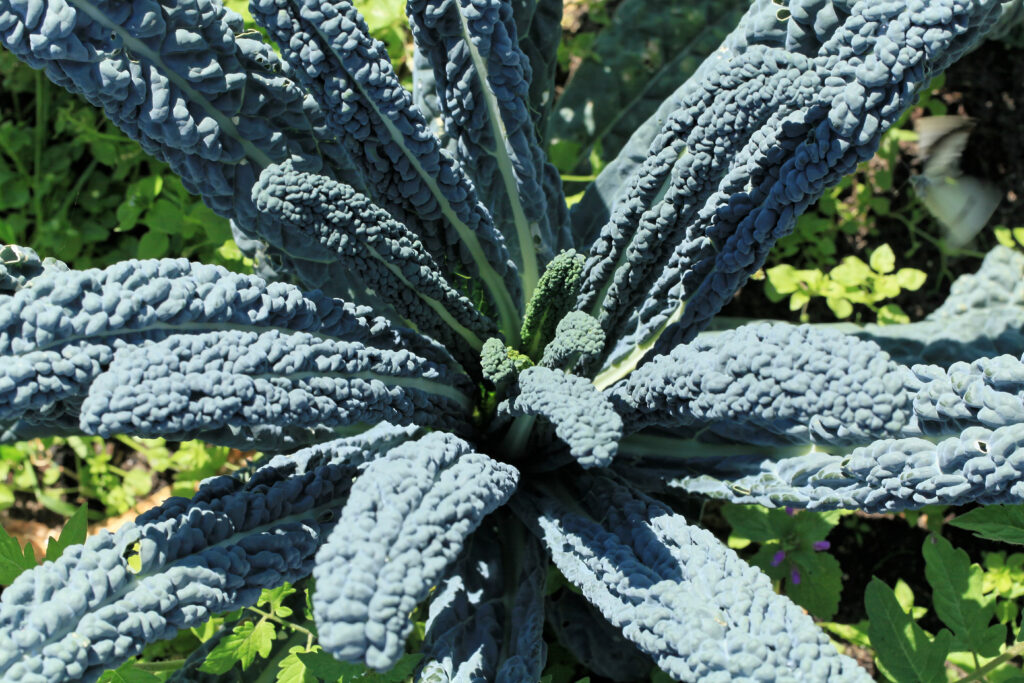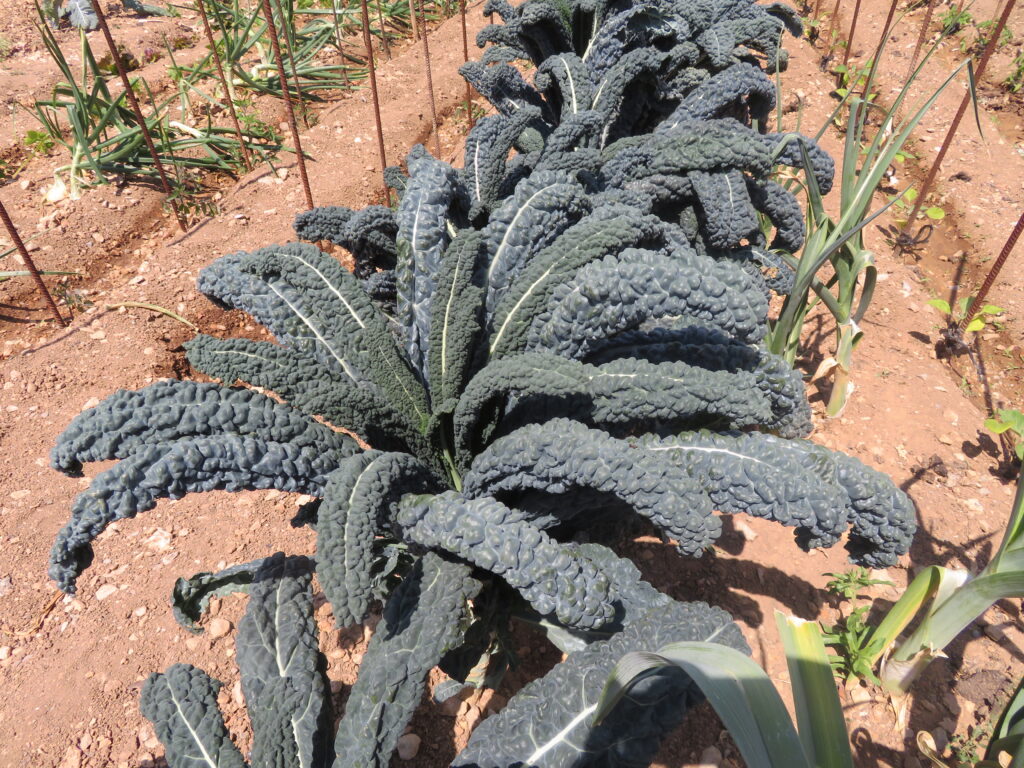Lacinato kale, often called dinosaur kale or Tuscan kale, is a dark, leafy green vegetable recognized for its distinct texture and mild, somewhat nutty flavor. Its nickname, “dinosaur kale,” refers to the bumpy, wrinkled surface of its leaves, which resembles prehistoric skin. Italian cuisine has used this kale cultivar for generations, particularly in robust soups and rustic meals.
Why is lacinato kale so popular?
Lacinato kale is notable not only for its flavor but also for its tremendous health advantages, diversity in cooking, and ease of cultivation. It is a nutritional powerhouse, rich in vitamins A, C, and K, as well as antioxidants and fiber. Its tender yet strong leaves are ideal for salads, soups, and sautés, and its hardiness in the garden makes it a favorite of both experienced and novice gardeners.
This book will teach you everything you need to know about lacinato kale, including its benefits, how to cultivate it at home, and delicious dishes to try. Whether you’re a health buff, a gardener, or a foodie, there’s something for everyone here!
The Health Benefits of Lacinato Kale
Lacinato kale is not only a tasty addition to your meals; it is also a nutritional powerhouse with several health advantages. Let’s look at why this leafy green is essential to your diet.
1. Nutrient-rich.
Lacinato kale contains necessary vitamins and minerals while being low in calories. It is especially high in:
Vitamin A promotes healthy skin and vision.
Vitamin C stimulates collagen formation and improves immunity.
Vitamin K promotes blood coagulation and bone health.
Additionally, it contains iron, potassium, and magnesium, all of which are essential for overall health.
2. Boosts immunity.
Lacinato kale is high in antioxidants like beta-carotene and flavonoids, which help fight free radicals and boost the immune system. These substances can lower oxidative stress, making your body more adaptable to sickness.
3. Promotes bone health.
Because of its rich vitamin K and calcium content, lacinato kale maintains strong bones and lowers the risk of osteoporosis. One cup of cooked lacinato kale has more than 100% of the daily required amount of Vitamin K!
4. Aids digestion.
Lacinato Kale’s high fiber content promotes regular bowel movements and helps maintain gut health. Fiber also helps you feel fuller for longer, which is beneficial for weight management.
5. May reduce inflammation.
Lacinato kale includes anti-inflammatory components such as omega-3 fatty acids and potent antioxidants. They can help reduce inflammation, which is associated with chronic conditions like arthritis and heart disease.

How To Grow Lacinato Kale
Growing lacinato kale at home is both simple and satisfying. This resilient leafy green thrives in a variety of environments and is ideal for gardeners of all levels. Here’s a step-by-step method for growing your own fresh, healthy lacinato kale.
4.1. Optimal Growth Conditions
To grow healthy and fruitful lacinato kale, you will need to supply the following conditions:
- Climate: Lacinato kale thrives in cool temperatures, making it suitable for spring and autumn planting. It can withstand light frosts, which can even enhance its flavor.
- Soil Type: Select a well-drained soil rich in organic materials. A somewhat acidic pH of 6.0 to 7.0 works well.
- Sunlight: Provide at least 6 hours of direct sunlight per day. Partial shade is appropriate in hotter areas.
- Watering: Keep the soil regularly moist but not overly wet. Aim for 1 to 1.5 inches of water every week.
4.2. Planting Guide:
Step-by-Step Selection of Seeds. Select high-quality lacinato kale seeds from a reliable seller.
- Planting depth: Sow the seeds about 1/4 to 1/2 inch deep in the soil.
- To allow enough growth, space seeds or seedlings 12–18 inches apart. Rows should be 18 to 24 inches apart.
- Timing: Sow spring crops 3-5 weeks before the final frost date. Plant autumn crops six to eight weeks before the first frost.
4.3. Care for Lacinato Kale
Proper care is necessary for a healthy harvest.
- Fertilization: To offer nutrients, apply a balanced fertilizer or compost. Apply every 4-6 weeks throughout the growing season.
- Pest Control: Look for typical pests like aphids and cabbage worms. Use organic pest control options, such as neem oil, or introduce beneficial insects like ladybugs.
- Common Issues: Monitor for yellowing leaves, a sign of nutritional inadequacy, and leaf holes, a sign of pest damage.
4.4. Harvesting Tips.
- When to Harvest: Start harvesting when the leaves reach 8 to 10 inches in length. Harvesting can normally begin about 60 days after planting.
- How to harvest: Cut the outer leaves first, then allow the interior leaves to grow. Regular harvesting promotes new development and keeps the plant fruitful.
- Best flavor: Kale tastes nicer when harvested early in the morning or after a little frost.
Cooking using Lacinato Kale.
Lacinato kale is a versatile component that works well in a wide range of recipes. Its somewhat nutty flavor and soft yet strong structure make it popular in both raw and cooked meals. Let’s learn how to prepare and cook this nutritious superfood.

5.1. How to Prepare Lacinato Kale.
Preparing lacinato kale is straightforward and ensures the greatest flavor and texture.
- Cleaning: Rinse the leaves well with cold water to remove dirt and grit. Pay close attention to the creases and crevices in the leaves.
- To remove tough stems, fold the leaf in half lengthwise and cut or rip away the thick stem that runs along the center. This process helps create a more sensitive eating experience.
- Chopping: You can leave the leaves whole, cut them into ribbons, or tear them into bite-sized pieces, depending on the recipe.
5.2. Popular Cooking Methods
There are several ways to serve lacinato kale, each emphasizing its unique flavors:
- Add it to salads for a crisp, somewhat chewy texture. Massaging the leaves with olive oil and lemon juice softens and enhances their flavor.
- Sautéed: For an effortless and delicious side dish, lightly sauté garlic and olive oil together.
- Roasted: Bake the leaves to make crispy kale chips, which are a delicious and healthful snack.
- Blended: Add to smoothies for a nutritional boost without dominating flavor.
- Soups and stews: The substantial texture of this ingredient works well in soups like Tuscan kale and white bean soup.
5.3. Top Recipes.
Here are some must-try dishes that include lacinato kale:
- Lacinato Kale Salad with Lemon Dressing: The salad is light and delicious, featuring massaged kale, cherry tomatoes, parmesan, and a zesty lemon vinaigrette.
- Tuscan Kale and White Bean Soup: This soup is a hearty Italian-style dish that combines delicate kale, creamy cannellini beans, and a flavorful broth.
- Crispy Kale Chips: A quick, healthy snack. Toss kale leaves with olive oil and your favorite seasonings before baking till crisp.
- Sautéed kale with garlic and olive oil: This classic side dish goes nicely with any dinner. Sauté the kale in olive oil with minced garlic, salt, and a touch of lemon.
Conclusion
Lacinato kale is a gorgeous leafy green that belongs in your kitchen and garden. With its high nutritional value, variety in recipes, and ease of growing, it’s no surprise that this vegetable has been a favorite for ages. You can enjoy lacinato kale raw in a crisp salad, sauté it with garlic for a quick side dish, or blend it into a hearty soup due to its versatility.
Incorporating lacinato kale into your meals and learning to produce it yourself will not only improve your health but will also introduce you to a sustainable and flavorful ingredient that will upgrade your culinary skills. So, whether you’re a health nut, a home grower, or a culinary explorer, lacinato kale is a superfood to celebrate!










